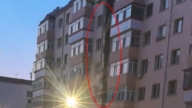【新唐人2011年6月28日讯】大陆地方政府放任“非法垃圾场”存在,造成各地“垃圾围城”的景象。摄影师王久良,用黄色标签把遍布在北京巿郊的“非法垃圾场”一个个标示出来,形成了密密麻麻的黄色“七环”地图。而不只北京,相同的问题已出现在中国各地。
《广州日报》27号报导,长期追踪“非法垃圾场”问题的独立摄影师王久良,在网路上发表名为“垃圾围城”系列照片,告诉人们中国各地非法垃圾填埋场污染环境的问题有多严重。
填满了垃圾的几十米深大坑、焚烧垃圾引发的浓烟、到处都是蚊蝇…王久良说:“他在地图上标注出来的“非法垃圾场”就有四、五百处,主要分布在北京巿郊的农村地区。”
2008 年10 月开始追踪“非法垃圾场”的王久良,曾经和《中国网事》的记者实地探访一家非法垃圾场,进村不到2公里就闻到浓烈的臭味。穿过树林,一个足球场大小的垃圾场就在眼前,垃圾的腐败味道快让人喘不过气来。而这些非法垃圾处理场的背后,业者从租地,回收,分拣,到填埋,最后留下一个个被污染的自然环境。王久良感慨:比如一个经营的还不错的鱼塘,几个月后变成垃圾场。只因为老板认为“倒垃圾比养鱼更赚钱”。美好的自然环境就这样一个个消失了。
不只北京,相同的问题已出现在中国各地 。比如最近《苹果日报》报导的广西昭平县“黄姚古镇”,这座千年古镇,在地方政府的放任下,每天数以吨计的垃圾几乎没有经过处理就任意堆放,流出的污水已威胁到下游城镇的饮水安全。当局只顾赚钱不顾环境的心态,让秀丽古镇变成另一座“垃圾围城”。
有民众向媒体投诉,各地非法垃圾场林立,主要还是因为垃圾场可以在短时间内赚取暴利。上月底(5月23号)《中国之声》报导,贵州贵阳市乌当区东风镇的镇民向记者投诉:2006年以来,他们镇里的耕地被违规兴建了三座非法垃圾场,每座占地80亩左右,全变成了垃圾山。
报导指出,其中的“广西冲倒土场”的负责人王士兵说,这倒土场是他从别人手里用人民币120万转手过来的,每年大约付给村民租金15万,加上村委的管理费几万块。倒土场每辆车每次收100块钱,用每天100辆车次计算,倒土场每年收益300多万。乌当区现有的倒土场,也就是这类的非法垃圾场,共有20多座。
乌当区城管局渣土所的解释是,他们有进行监管,兴建倒土场的申请手续必须由当地村委会上报镇政府,经过乌当区林业局、环保局、国土局和规划局盖章,及现场勘察后才能上报市局核可。
不过《中国之声》的记者随后采访了乌当区国土局和规划局,他们却都表示,倒土场的审批不须经过他们,只由城管负责管理。目前基本上也没什么申报手续,因为建设局本身也不太重视。
新唐人记者曾耀贤、王明宇综合报导。
Fishponds Turned Into Dumps
Due to Chinese local governments’ scant regulation,
illegal dumps surrounding cities are commonplace.
Photographer Wang Jiuliang labeled illegal dumps
with yellow stickers on a map of Beijing.
Illegal dumps are now a nationwide issue in China.
Photographer Wang Jiuliang posted online
his photo collection named City in Dumps,
Guangzhou Daily reported on June 27.
Wang aims to underline the problem of illegal dumps.
His photos show large pits filled with garbage,
and heavy black smoke from burning dumps.
There are 4~500 illegal dumps surrounding Beijing.
Wang started to focus on illegal dumps in Oct 2008.
He once visited one illegal dump with a reporter.
They could smell strong stink in the village.
There was a dump of the size of a football field,
with a disgusting and unbearable smell.
Through land rental, recycling, garbage sorting and
landfill, dumps gradually destroyed the environment.
Wang sighed over fishponds being turned into dumps,
because “dumps are more profitable than fishponds”.
The environment has been destroyed in this way.
Illegal dumps are a nationwide phenomenon.
Hong Kong’s Apple Daily reported that in Huangyao,
an ancient town, tons of wastes are dumped daily.
Without government regulations or recycling,
the town’s sewage has endangered the downstream cities.
A scenic old town was turned into a city of dumps,
as local officials only care about generating profits.
Some residents have complained to the media that
the proliferation of dumps is due to their profits.
Chinese media reported on May 23 that since 2006,
three illegal dumps had been built in Dongfeng,
Guiyang City of Guizhou. Farm lands were seized
and each dump was 53,000 square meters.
The head of Guangxi Dumps, Wang Shibing said,
this dump was purchased with RMB 1.2 million.
He pays an annual rent of RMB 150,000 to villagers,
as well as some administration fees to village officials.
He collects RMB 100 for garbage dumped per truck.
There are approximately 100 cars a day.
The dump can earn over RMB 3 per year.
There are about 20 such illegal dumps in the region.
The local official explained that they did supervise,
and the dump establishment was reported to
the local village committee and the town authorities,
with the approval of Bureau of Forestry, Bureau of
Environment Protection and Land and Resources.
When asked by a reporter from China Voice,
the local bureau of Land and planning said that
they were not in charge of approving dump setups.
This was in the responsibility of city administration.
Also, there are no application procedures.
NTD reporters Zeng Yaoxian and Wang Mingyu





























